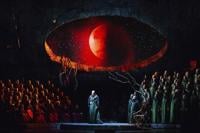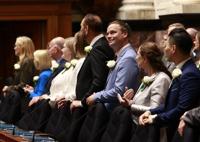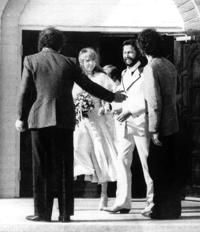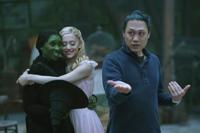NEW YORK (AP) — Günther Groissböck was about to walk onstage at Moscow’s Bolshoi Theatre for the first act of a new “Lohengrin” production last winter when his wife, Isabel, texted that she and their 12-year-old daughter were about to take off on a flight home to Milan.
“Then she texted me back and said, no, the pilot just announced we are ,” the Austrian bass recalled. “And then they were trapped because they only had the one entry visa.”
13 hours before the opening performance of François Girard’s staging of the Wagner opera — a production that starts the second half of the Metropolitan Opera’s season on Sunday. The war quickly impacted the cast and audience at the Bolshoi, a short walk from the Kremlin. And would lead the Met to scrap using the Russian set and build a duplicate.
“Something happened in the theater that night that was incredible — the energy on stage and in the house. At first I thought I had some responsibility in that, and I thought it was like a success,” Girard recalled this week. “But then I think a large part of that energy was a protestation to across the street.”
Groissböck’s family eventually got home via Istanbul, and Girard left Moscow a day earlier than scheduled.
Met general manager Peter Gelb had attended the final dress rehearsal in Moscow because the staging was planned as a coproduction of the companies.
“When I returned to New York and the invasion had begun, I immediately made the decision to sever ties with any official Russian institution or artist associated with (Vladimir) Putin,” Gelb said.
At a cost of more than $1 million, the Met had another set built by Bay Productions in Cardiff, Wales, and costumes constructed in New York and Hong Kong. Because of the change, technical rehearsals were postponed from August to February.
Girard is directing his third Wagner opera at the Met, following an in 2013 and a that received mixed reviews in 2020,
“Lohengrin” is the Met’s most-seen Wagner opera with 717 performances. A minimalist staging by Robert Wilson featuring bars of light premiered in 1998 and replaced an August Everding version dating to 1976. Wilson's staging was revived just twice and was given only 19 total performances, the last in 2006.
Met music director Yannick Nézet-Séguin conducts a cast this weekend that includes tenor Piotr Beczala in the title role, Groissböck (King Heinrich), bass-baritone Evgeny Nikitin (Telramund) and sopranos Tamara Wilson (Elsa) and Christine Goerke (Ortrud),
"Lohengrin’ is maybe Wagner’s first attempt at the magic, the ethereal, the celestial, dare I say dreamy music. That is apparent right away from the prelude,” Nézet-Séguin said. “There is an otherworldly quality in both scores. However, `Lohengrin,′ also because probably being earlier than ‘Parsifal,’ also is a confluence of some bel canto.”
Girard stages the opera in post-apocalyptic times, the prelude accompanied by the moon projected orbiting the earth and then exploding.
Lohengrin arrives with a projected swan image in the heavens and is wearing the same white dress shirt and dark trousers of the knights in Girard’s “Parsifal” production, signifying he was sent to Brabant by his father, the grail king. Otherworldly power is evident in the first-act sword fight with Telramund, which Lohengrin wins using mental powers rather than a physical weapon.
Innovative hooded robes designed by Tim Yip, an Academy Award winner for art and set decoration of “Crouching Tiger, Hidden Dragon,” enable the chorus and dancers to change colors. Inside the black cotton outer coat are three silk double-layers that represent which faction the chorus is singing about: green for King Heinrich and royal authority; red for the primitive civilization of Telramund and Ortrud; and white for Lohengrin, Elsa and purity.
Chorus members change colors with magnets at hand level.
“Every costume you have has to fit perfectly,” Yip said. “The hand has to be just there, not like other costumes where you can have a little height adjustment.”
There are 10 performances through April 1, and the March 18 matinee will be simulcast worldwide.
Girard is staying in New York to direct the U.S. premiere of Yasushi Inoue’s “The Hunting Gun” at the Baryshnikov Arts Center starting March 16 and then a revival of “Dutchman” at the Met opening May 30.
“This music is written for extraterrestrials. It’s not written for human beings,” Girard said. “The more I do Wagner, the more difficult it is for me to even consider going anywhere else in the repertoire.”








































